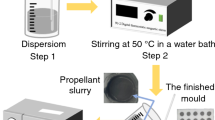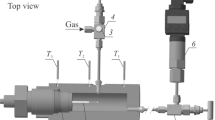Abstract
The intense exhaust plumes of the CMDB propellants can be suppressed by the containing potassium salts, but the potassium compounds increased remarkably the combustion pressure exponent of propellants, destroying the combustion plateau effects and resulting in the combustion instability of the rocket motors, so it is critical to reveal the reaction mechanisms of the potassium salts during the combustion process of propellants. In the work, the influence of three potassium hexanitro complexes, K2Pb[M(NO2)6] (M = Co, Cu, Ni), on the ignition and combustion properties, especially pressure exponent, of solid propellants has been investigated by using the laser ignition apparatus, burning rate instrument, combustion wave temperature, flame morphology, quenched surface, and emission spectrometer. When the hexanitro complexes replaced the β-Pb, the ignition delay time of the propellants was shorter at the low laser flux. The study on the combustion properties showed that the burning rate and pressure exponent of propellant containing K2Pb[Cu(NO2)6] was extremely close to the basic propellant (β-Pb) due to similar temperature gradient until ~ 1942 °C. The flat combustion cross section on the flame morphology of the propellant containing K2Pb[Cu(NO2)6] was found to favor the low-pressure exponent. The carbon skeleton, metal agglomerations, and K release identified by using the quenched surface and emission spectra were closely related to the response characteristics of the combustion pressure exponent of the propellants due to the influence of different hexanitro complexes. The relationship between the burning rate of the propellants and the maximum self-heating rate of the mixtures containing the propellant energetic oxides and hexanitro complexes was also revealed, which can predict the relative burning rate for the same propellant system. More importantly, the reasons for the deterioration of the combustion pressure components due to flash suppressors were elucidated clearly from the experimental results and theoretical analysis, which involve three destroying mechanisms: (i) catalytic metals “poison,” (ii) carbon skeleton disappearance, and (iii) high thermal decomposition temperature of potassium compounds. The study also revealed the inhibition mechanism of potassium flash suppressors on the catalytic properties of catalysts during the combustion process of the CMDB propellants.
Graphical abstract
The influence of three potassium hexanitro complexes on the ignition and combustion properties of solid propellants have been investigated, and the reasons for the deterioration of the combustion pressure components due to flash suppressors were elucidated clearly.









Similar content being viewed by others
References
Kuo KK, Kim JU, Fetherolf BL, Torikai T. Preignition dynamics of RDX-based energetic materials under CO2 laser heating. Combust Flame. 1993;95:351–61.
Yuan ZF, Yang YJ, Zhao FQ, Zhang JQ. Effects of different content of nanomaterials on the combustion performance of RDX-CMDB propellants. Chi J Explos Propellants. 2019;42(566–570):582.
Sims S, Fischer S, Tagliabue C. ADN solid propellants with high burning rates as booster material for hypersonic applications. Propellants Explos Pyrotech. 2022;47: e202200028.
Pang WQ, Wang K, Xu HX, Fu XL, Li JQ, Li H, Deng CQ, Fan XZ. Performances of low signature fuel rich propellant with hydrocarbon fuel. J Solid Rocket Technol. 2018;41:732–9.
Yan QL, Zhao FQ, Kuo KK, Zhang XH, Zeman S, DeLuca LT. Catalytic effects of nano additives on decomposition and combustion of RDX-, HMX-, and AP-based energetic compositions. Prog Energ Combust. 2016;57:75–136.
Yim YJ, Jang MW, Park EY, Lee JS, Han H, Lee WB, Song SH, Kim MT, Yoo JC, Yoon MW. Infrared irradiance reduction in minimum smoke propellants by addition of potassium salt. Propellants Explos Pyrotech. 2010;35:1–8.
Yang D, Zhao FQ, Li SW. Burning rate optimization of nitramine modified double base propellants with secondary flame inhibitors. J Propulsion Technol. 2000;4:50–4.
Li JQ, Li XJ, Liu P, Qi XF, Liu FL. Effect of performance with eliminated-flame additive on nitramine modified double base propellant. Chin J Energ Mater. 2010;18:290–4.
Li HJ, Yi JH, Qin Z, Sun ZH, Xu Y, Wang CJ, Zhao FQ. Influence of afterburning suppression on the combustion of solid propellants: recent progress and outlook. J Phys: Conf Ser. 2020;1507: 022020.
Qi XF, Li JQ, Zhang XH, Li XJ, Zhang W, Liu P. Influence of energetic potassium salt as eliminated-flame additive on performance of nitramine modified double base propellant. Chin J Energ Mater. 2013;21:334–8.
He W, Lyu JY, Tang DY, He GQ, Liu PJ, Yan QL. Control the combustion behavior of solid propellants by using core-shell Al-based composites. Combust Flame. 2020;221:441–52.
Trache D, DeLuca LT. Energetic materials for propulsion applications. FirePhysChem. 2023;3:i–iii.
Wang Y, Xia X, Zhu J, Li Y, Wang X, Hu X. Catalytic activity of nanometer-sized CuO/Fe2O3 on Thermal decompositon of AP and combustion of AP-based propellant. Combust Sci Technol. 2010;183:154–62.
Singh G, Felix SP. Studies of energetic compounds, part 29: effect of NTO and its salts on the combustion and condensed phase thermolysis of composite solid propellants. HTPB-AP Combust Flame. 2003;132:422–32.
Li W, Cheng H. Cu–Cr–O nanocomposites: synthesis and characterization as catalysts for solid state propellants. Solid State Sci. 2007;9:750–5.
Singh G, Kapoor IPS, Dubey S. Bimetallic nanoalloys: Preparation, characterization and their catalytic activity. J Alloys Compd. 2009;480:270–4.
Qin Z, Yi J, Pang W, Wang C, Li H, Xu H, Qu B, Zhao F, Hao N, Huang X. Effect of spherical Al-Mg-Zr on the combustion characteristics of composite propellants. FirePhysChem. 2022;2:14–9.
Zhang M, Zhao FQ, Yang YJ, An T, Qu WG, Li H, Zhang JK, Li N. Catalytic activity of ferrates (NiFe2O4, ZnFe2O4 and CoFe2O4) on the thermal decomposition of ammonium perchlorate. Propellants Explos Pyrotech. 2019;44:1–10.
Li H, Liu B, Yi X, Wang C, Sun Z, Li H, Yao E, Yi J, Qin Z, Zhao F. Tunable catalytic activity of energetic multi-metal hexanitro complexes for RDX decomposition and ignition. J Anal Appl Pyrol. 2021;157:105228. https://doi.org/10.1016/j.jaap.2021.105228.
Yang ZW, Guo XD, Liu HY, Wu XY, Li FS. Preparation and properties of submicron energetic nitro complex K2Pb[Co(NO2)6]. J Solid Rocket Technol. 2014;37(1):77–80.
Elliott H, Hathaway BJ, Slade RC. The Properties of the hexanitro complexes of divalent iron, cobalt, nickel, and copper. Inorg Chem. 1966;5:669–77.
Xia L, Guo XD, Liang L, Wu RQ, Wei XL, Guo XJ. Effect of energetic combustion catalyst K2Pb[Cu(NO2)6] on performance of RDX-CMDB propellant. J Solid Rocket Technol. 2020;43:489–95.
Liao XQ, Liu H, Liu JZ, Xu PH, Du LJ. Study on the ignition combustion and agglomeration mechanism of GAP/CL-20 composite propellants. J Therm Anal Calorim. 2023;148:4141–50.
Zhang M, Zhao F, Li H, Yuan Z, Dong S, Wang Y, Chen X, Yang Y, Song X, Jiang Z. Insight into graphene-salen metal nanocomposites on combustion performance and mechanism of HMX-CMDB propellant. Chem Eng J. 2022;429:132175. https://doi.org/10.1016/j.cej.2021.132175.
Xu S, Pang A, Kong J. Decomposition mechanism and kinetic investigation of novel urea burning rate suppressants in AP/HTPE propellants. J Therm Anal Calorim. 2023;148:12811–20.
Yuan J, Liu J, Zhang L, Peihui X, Chen D, Yang W. Combustion and agglomeration characteristics of boron particles in boron-containing fuel-rich propellant. Combus Flame. 2021;232:111551. https://doi.org/10.1016/j.combustflame.2021.111551.
Kramida A, Ralchenko Y, Reader J. NIST Atomic Spectra Database (Version 5.3). National Institute of Standards and Technology, Gaithersburg, MD 2015.
Zhao FQ, Chen P, Li SW, Yin CM, Liu ZR. Effect of potassium salt flame suppressors on the thermal decomposition behavior of the combustion catalysts used in solid propellant. J Solid Rocket Technol. 2002;25:26–9.
Chen P, Zhao FQ, Li SW. The study on the quenched surface characteristics of NC/TMETN propellant with potassium salt. Chin J Expl Propell. 2002;3:47–53.
Yang D, Song HC, Li SW, Chen SL. Numerical simulation of the burning rate pressure index of nitramine modified double based propellants. Chin J Expl Propell. 1999;22:56–9.
Acknowledgements
This work was supported by the National Natural Science Foundation of China (22375159, 21473130, 21905224) and the Natural Science Foundation of Shaanxi Province, China (2020JQ-984). The authors would like to thank Dr. Yan Zhang, and Zhihua Sun, and Dr. Heng Li for the tests of laser ignition and combustion properties.
Author information
Authors and Affiliations
Contributions
Haijian Li involved in writing—original draft, funding acquisition, and data curation. Chao Chen involved in data curation. Yi Xu involved in investigation. Zhao Qin involved in funding acquisition. Xiao Xie involved in conceptualization. Ergang Yao involved in methodology. Siyu Xu involved in funding acquisition. Wengang Qu involved in resources. Jianhua Yi involved in writing—review. Fengqi Zhao involved in supervision.
Corresponding authors
Ethics declarations
Conflict of interest
The authors declare that they have no known competing financial interests or personal relationships that could have appeared to influence the work reported in this paper.
Additional information
Publisher's Note
Springer Nature remains neutral with regard to jurisdictional claims in published maps and institutional affiliations.
Supplementary Information
Below is the link to the electronic supplementary material.
Rights and permissions
Springer Nature or its licensor (e.g. a society or other partner) holds exclusive rights to this article under a publishing agreement with the author(s) or other rightsholder(s); author self-archiving of the accepted manuscript version of this article is solely governed by the terms of such publishing agreement and applicable law.
About this article
Cite this article
Li, H., Chen, C., Xu, Y. et al. Response characteristics of combustion pressure exponent of propellants: compensation effect of three energetic potassium lead complexes with Co, Cu, Ni. J Therm Anal Calorim (2024). https://doi.org/10.1007/s10973-024-13144-1
Received:
Accepted:
Published:
DOI: https://doi.org/10.1007/s10973-024-13144-1




